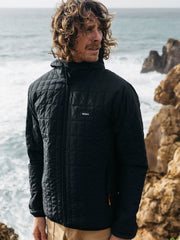But despite my lust for adventure travel, I love to be at home on Atlantic shores, witnessing the large tidal range skirting a crescent of ground quartz and mica sand at high and revealing a plane of rivulets and rock pools at low. The smell of coconut and pineapple emanates from gorse-flower, while birds hover above the cliffside, eying prey, a fresh swell running. And it's here where my kids are hooked on the intense moments of pleasure that a ride can bring, even if only seconds long, while my dad (who taught me to surf), is now well into his 70s, and still surfing daily. We’re never too old to surf. Only injury and physical infirmity will stop us, because our mind will be way younger than our body. Part of the continuing lure is that surfing is not easy - it is a challenge, but one that is addictive. Moments of pure glide on a wave are impossible to achieve on land. Surfing is not just keeping your body in some sort of shape, but also continually working on the mind. Telling ‘old salt’ tales is reminiscence therapy. Putting together a half decent takeoff, bottom-turn, trim, kickout combination is in large part muscle memory. As the pattern of neurons fires, so an activity done thousands of times unfolds, but it unfolds differently on every wave. Surfing is living, wide-eyed, in the midst of that surprise.
Listening to my kids talk about surfing is infectious. Perhaps she’ll be embarrassed about this, but a few years ago my daughter Lola wrote in her diary, “I love surfing. If l don't want to go into the sea, l push myself to go in, and when l catch a wave, BOOM, l want to keep going. Every time I catch a new wave my heart gets showered with happiness. If you tune into the source of nature it can take you to another place.” These are pretty good reasons for why we surf. And my five-year-old son Ruben also loves getting into the Atlantic grind. Recently, while hunched over the laptop, he said, “Dad. Be less busy. Let’s go and play in the waves.” We are all too busy, and surfing with kids is a great remedy, showering stress with saltwater. We cannot be children again as adults, but we can recapture the spontaneity, imagination and freshness of childhood through surfing regularly. The cycle of taking off to kicking out can last seconds, or minutes if you are lucky. Rides are relatively short given the amount of time we spend paddling out, duck-diving and waiting for sets. With all this space and time I am always reminded of why I surf. The coast is like a huge outdoor classroom that facilitates such a wonderful understanding of ourselves (our limits, desires and passions and abilities), the environment (particularly coastal change and ocean and beach pollution) and culture (of celebrating difference and cultural exchange). Difference and ‘otherness’ are important issues to confront on the planet because positive cultural exchange is a way we can all become more tolerant of one another, and live more peacefully by celebrating our rainbow-spectrum of approaches. But caring for the planet we all share is key, and without that shared responsibility as a priority for all people, we simply destroy the blue and green spaces that future generations have a right to surf in. And I definitely want my kids, and their kids, to share these worldwide passions for waveriding in clean, clear waters so they can share what the sea means to them with the same amount of passion we can today.

















































































